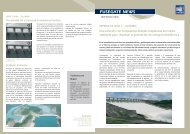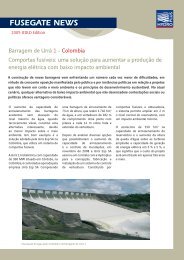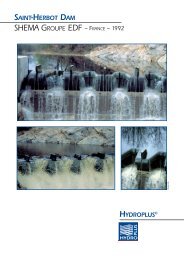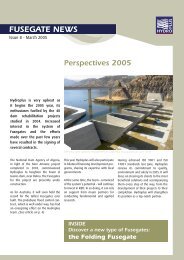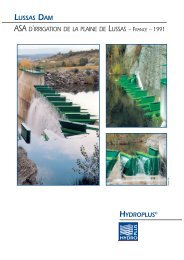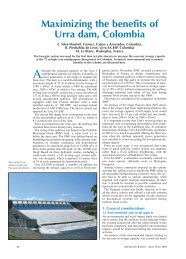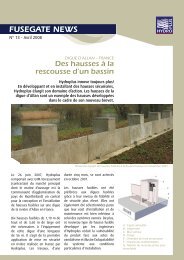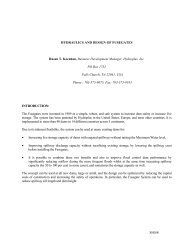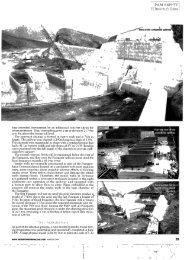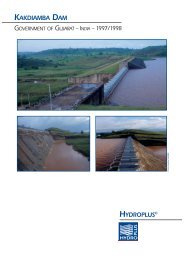Fusegate News N°12 - November 2007 - Hydroplus
Fusegate News N°12 - November 2007 - Hydroplus
Fusegate News N°12 - November 2007 - Hydroplus
- No tags were found...
You also want an ePaper? Increase the reach of your titles
YUMPU automatically turns print PDFs into web optimized ePapers that Google loves.
Issue 12 - <strong>November</strong> <strong>2007</strong>In June <strong>2007</strong>, <strong>Hydroplus</strong> was awardeda contract for the design andinstallation of 10 fusegates, 1.10 mhigh and 5.60 m wide, at a retentionbasin on the Allan River in easternFrance. The first unit is designed totip off for floods with a probability ofoccurrence in excess of 1 in 70 years.This is the first river-based dam safetyupgrade carried out by <strong>Hydroplus</strong> inFrance. Work was completed at theend of October <strong>2007</strong>.ALLAN RIVER – FRANCE<strong>Fusegate</strong>s on a floodretention basinThe retention basin consists of adyke, built across a valley, with afree overflow weir limiting river flow.Floodwaters are thus stored behind thedyke, resulting in reduced downstreamflow. A 56-m-long emergency spillwayensures the safety of the dyke againstovertopping.Close-up view on the Allan fusegates and their specialwell structure preventing vandalism.Given their reliability and safetyfeatures, fusegates were favoured asthe spillway control system over fuseplugs. <strong>Fusegate</strong>s were also preferredto flap gates due to their low-maintenance requirements and costeffectiveness.An innovative designprotecting fusegates against vandalismwas also implemented as part of thisproject. This new feature testifies to the<strong>Hydroplus</strong> technical team’s continuousefforts to enhance their ability torespond to new challenges.CANTON DAM – USAReaching new heightsCompleted in 1951, Canton dam nearOklahoma City consists of a 23-m-high,4,600-m-long earthfill embankment.Following a study that revealed thedam’s insufficient flood-dischargecapacity, plans were made to build anew emergency spillway to provideadequate flood protection.To that end, 9 fusegates – at 9.14 m,the tallest ever built – will be installedon the existing dam, increasing itstotal discharge capacity from 9,900 to18,000 m 3 per second. The first stage ofthe <strong>Hydroplus</strong> design and engineeringcontract is related to model testsdesigned to optimize the emergencyspillway channel configuration.This $1.8-million engineering contractis the fifth mandate for <strong>Hydroplus</strong>in the United States and the third inpartnership with the U.S. Army Corps ofEngineers.
FUSEGATED SPILLWAYSThe Ghrib dam: a success storyThe recent rehabilitation of theGhrib dam, which was equippedwith 20 fusegates 4.50 m high,provides an opportunity tocompare labyrinth weirs andfusegated spillways.The Ghrib dam, operated by theNational Agency of Dams and Transfers(ANBT), is the second most importantdam under operation in the westernpart of Algeria. Built in the 1940s, thestructure was designed to irrigate theMitidja valley and High and Low Cheliffregions and to provide water supply forthe capital, Algiers.Two solutions were compared in 2004 toincrease the reservoir storage capacityby 70 millions m 3 while keeping thesame discharge capacity at MaximumWater Level: a fixed labyrinth weir anda fusegated spillway.The labyrinth weir alternativeFrom a structural and constructionpoint of view, this option would haveconsisted in building a fixed labyrinthmade of reinforced concrete with 17waves, each 40 m long and 10 m wide.The fixed labyrinth would have beenerected on the upstream side of theexisting ogee sill.gates, each 4.50 m high by 10 m wide,in order to retain rapid drawdowncapacity in case of problems. Accordingto model tests performed by Algeria’sCTH Laboratory, despite the magnitudeof the labyrinth waves, this solutionwould have limited the maximumdischarge capacity of the spillway to4,500 m 3 per second, which was wellbelow the existing spillway dischargecapacity of 7,000 m 3 per second whenthe water level reaches the dam crest.Therefore, this solution was acceptableto pass the Design Flood but notthe PMF, which according to ICOLDrecommendations should be passedbelow the dam crest for high damssuch as the Ghrib.Fixed labyrinth : spillway plan viewModifications to the existing ogeewere also involved, as follows:• Installation of 50 dynamic anchors,30 m long to stabilize the ogee sillagainst the foundation; and• Flattening of the existing ogee sill andconstruction of a reinforced concreteplatform 185 m long and 5 m wide ontop.From a hydraulic point of view, thissolution did not limit the maximumdischarge capacity of the spillwayin case of PMF, the fusegates beingwashed away in case of extremefloods.The preferred solutionThe fusegate alternative was chosenbecause it:• Did not jeopardize the dam safety’swith regard to the PMF;• Respected ICOLD recommendationswith regard to the PMF; and• Was 30% more cost-effective andcould be implemented in a muchshorter time than the fixed labyrinthsolution.The construction would have required22,000 m 3 of excavation work and23,400 m 3 of concrete casting.Furthermore, the fixed labyrinth wouldhave involved the erection of a majorcofferdam, or a significant loweringof the reservoir level during theconstruction phase, which would haveled to significant water loss.From a hydraulic point of view, the fixedlabyrinth would have required 2 classicThe fusegate alternativeThis solution involved the installationof 20 labyrinth fusegates, 4.50 m highand 6.75 m wide, made of 30 m 3 ofreinforced concrete. They were cast onsite and associated with 2 flap gates,4 m high by 15 m wide, made from22 tonnes of steel. This configurationrequired 10,000 m 3 of excavation workand 1,200 m 3 of concrete casting.<strong>Fusegate</strong>d spillway : plan view2
Following a project to promoterenewable energy sources in Armenia,supported by the KfW DevelopmentBank of Germany, <strong>Hydroplus</strong> isparticipating in the rehabilitationof the currently disused Vorotnadam located in the southern partof Armenia. Seven fusegates, each1.50 m high and 2.70 m wide, will beinstalled on a new weir downstreamof the existing dam.RENEWABLE ENERGY<strong>Hydroplus</strong> in ArmeniaIn efforts to carry out the project in as costeffectivea manner as possible, fusegateswere selected as a spillway control systemto minimize the difference between thedam crest and the permanent pool level.Reliability was also a key factor in theselection of the fusegate system.This new contract reinforces the fusegatesystem’s reputation as a robust solution foroptimizing existing and new dams. Othersimilar projects are under considerationin Armenia.MOROCCOOptimizationstudiesIn April <strong>2007</strong>, <strong>Hydroplus</strong> was awarded acontract sponsored by the government ofFrance to study the optimization of damsowned and operated by the HydraulicWorks Directorate in Morocco.During Phase 1, engineers visited thirteendams to determine the potential forinstalling fusegates; they also collectedvaluable data about hydrology andwater demand. Following analysis of thisinformation, <strong>Hydroplus</strong> selected the fivemost promising dams, whose upgradewould provide additional storage of 70million m 3 .The Hydraulic Works Directorate approvedthis selection and launched Phase 2 ofthe project. Currently under way arefeasibility studies of the selected dams,which include a hydrology study, thedesign of the fusegate system, and acost-benefit estimate for the project.This is the first fusegate project for<strong>Hydroplus</strong> in Morocco and should openthe doors to a very promising market inthat country.3The Vorotna dam will be upgraded with seven fusegates.<strong>Hydroplus</strong>, faithful to its creative spirit andits permanent search for innovation, is in theprocess of filing a new patent related tofusegates wells safety. This innovation will bedevelopped in the next <strong>Fusegate</strong> <strong>News</strong> issue.EventsANCOLD <strong>2007</strong>QUEENSTOWN, NEW ZELAND<strong>November</strong> 17 to 21, <strong>2007</strong><strong>Hydroplus</strong>5, cours Ferdinand-de-Lesseps92851 Rueil-Malmaison CedexFranceTel: +33 1 47 16 44 34Fax: +33 1 47 16 42 12E-mail: contact@hydroplus.com



